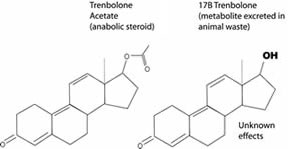Analogous Stressors
Concept
Analogous Stressors: Agents similar to the causal agent at the impaired site should lead to similar effects at other sites.

Click here for more information
Examples
Consider increased levels of a specific hormone as a candidate cause of reduced fish abundance. What findings support or weaken the case for this hormone as the cause, based on evidence from analogous stressors?
- Supporting evidence - Laboratory studies show that exposure to a hormone similar to the candidate cause, but with one side chain substitution, results in sex reversal and ultimately reproductive failure in fish.
- Weakening evidence - Laboratory studies show that exposure to a hormone similar to the candidate cause, but with one side chain substitution, has no discernable effect on fish.
How Do I Analyze the Data?
Data on analogous stressors can be collected from the literature or from other case studies. Pesticides, herbicides, and other chemicals with known mechanisms of action are good analogues for chemicals with similar mechanisms of action but with less available information on ecological effects. If the mechanism of action is unknown, the structure of molecules can be compared with various software packages to identify analogues. Mixtures of chemicals from a source similar to a source in the case also may be considered analogues.
What Evidence Would Support or Weaken the Case for a Candidate Cause?
- Data showing that agents similar to the candidate causal agent result in effects similar to those observed at the impaired site.
- Data showing that agents similar to the candidate causal agent do not result in effects similar to those observed at the impaired site.
How Do I Score the Evidence?
| Finding | Interpretation | Score |
|---|---|---|
| Many similar agents at other sites consistently cause effects similar to the impairment. | This finding strongly supports the case for the candidate cause, but is not convincing because of potential differences among the agents or in conditions among the sites. | ++ |
| One or a few similar agents at other sites cause effects similar to the impairment. | This finding somewhat supports the case for the candidate cause, but is not strongly supportive because of potential differences among the agents or in conditions among the sites. | + |
| One or a few similar agents at other sites do not cause effects similar to the impairment. | This finding somewhat weakens the case for the candidate cause, but is not strongly weakening because of potential differences among the agents or in conditions among the sites. | - |
| Many similar agents at other sites do not cause effects similar to the impairment. | This finding strongly weakens the case for the candidate cause, but is not convincing because of potential differences among the agents or in conditions among the sites. | -- |
Helpful Tips
- Analogy is commonly used with organic chemicals.
- The line between results from other sites that provide stressor-response from other field studies (i.e., the cause is considered to be the same) and those that are simply analogous is a matter of professional judgment. For example, the mixture of toxic metals from all chromium plating plants may be considered to be the same, because the processes generating the effluent are consistent, but the mixture of metals from municipal wastewater treatment plants may be merely analogous because the processes generating the metals are inconsistent.
